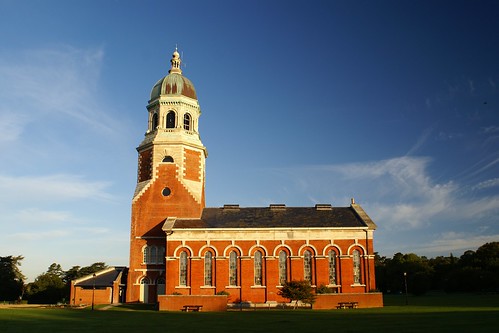Anyway, Hoare's lecture took in the history of the hospital, and that of its site, from when it was originally commissioned by Queen Victoria in 1856, through its part in two World Wars, to its eventual demolition after more than a century of use (and, potentially, misuse) in 1966. It being somewhere that I've visited many times over the years, not least because it has a great war cemetery, I've picked up some basic history but, as Hoare uncovered, only the slimmest of slim fractions.
Some of the most interesting parts of Hoare's account were how familiar certain tales about the hospital are to the modern audience. So, we started with the NIMBYs who protested its construction, and who, apparently, even claimed the risk of malaria to patients as a reason for building elsewhere. Then there were were the complaints that the resulting hospital wouldn't be fit for purpose from, of all people, Florence Nightingale. And on top of all that, the massive cost overruns that construction incurred, with the hospital ultimately costing more than twice its original budget. The lecture certainly made the 19th century seem strangely resonant to ostensibly 21st century concerns about big government projects.
It was particularly striking to hear how ill-planned and poorly executed quite important aspects of the hospital and its rationale were. Few, if any, of the painfully-gained lessons that Nightingale learned during the Crimean War were adopted into its design, and poor decisions often came back to haunt the hospital. For instance, Nightingale noted that, should the hospital need expanding, its linear design (an impressive 1/4 mile in length) would mean that expansion would be very difficult. Which was subsequently borne out during WWI, when injured troops were housed, albeit with improved treatment, in a "shanty town" of tents behind in the main building. Victorian Britain certainly felt more a part of the continuum of history rather than the exceptional Golden Age that it's sometimes presented as.
Also alarming, though more from the standpoint of 21st century medicine, were some of the practices employed at the hospital. Hoare recounted one tale involving leeches, spoke of the level of training afforded to nurses (let's just say it wasn't degree-level), and showed contemporary video footage of some rather unconvincing physical therapies. He also spoke about Netley Hospital's military asylum which served, effectively, as a holding facility for victims of "shell shock", as well as a source of dark, if unconfirmed, tales of drug experiments (interestingly, it's now used by the Hampshire Constabulary for training). Much of this is understandable in terms of the evolution of medicine as a discipline, but at the same time it was clear that patients were also viewed as, and treated as, guinea pigs by the doctors.
Overall, it was excellent. Talking without notes, and using only 30 or so vintage photographs for illustration, Hoare did a great job tracing out the biography of the hospital, from construction to destruction. He's clearly done a lot of formal research on the subject, but has also spoken to quite a number of people who either worked at the hospital while it was still open, or who somehow have a family connection - including the grand-daughter of the builder, who revealed some details about the costings. And he also presented quite a few of the loose ends of his digging, hints of stories that he'd come across but been unable to finally resolve. Being a "local boy", one who actually used to break into the hospital's derelict asylum, he was well aware of the familiarity of the location to his listeners, and the resonance the old hospital still has for some of the more senior ones. As a way of dramatising this, he spoke of how, during dry summers, the foundations of the hospital can appear as a ghostly shadow on the lawns that now overlie them.
Definitely recommended should he talk on the subject again.










No comments:
Post a Comment